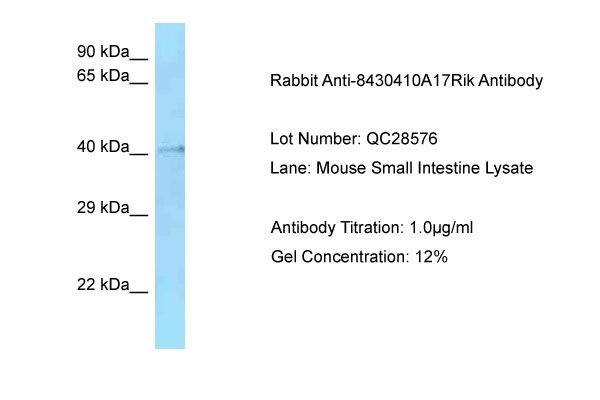8430410A17Rik antibody - N-terminal region
Rabbit Polyclonal Antibody
- 产品详情
- 实验流程
Application
| WB |
|---|---|
| Primary Accession | Q8R1M0 |
| Other Accession | NM_173737, NP_776098 |
| Reactivity | Human, Mouse, Rat, Rabbit, Pig, Dog, Horse, Bovine |
| Predicted | Human, Mouse, Rat, Rabbit, Pig, Dog, Horse, Bovine |
| Host | Rabbit |
| Clonality | Polyclonal |
| Calculated MW | 40169 Da |
| Gene ID | 232210 |
|---|---|
| Alias Symbol | C85376 |
| Other Names | Embryonic stem cell-specific 5-hydroxymethylcytosine-binding protein, ES cell-specific 5hmC-binding protein, Putative peptidase SRAPD1, 3.4.-.-, SRAP domain-containing protein 1, Hmces, Srapd1 |
| Format | Liquid. Purified antibody supplied in 1x PBS buffer with 0.09% (w/v) sodium azide and 2% sucrose. |
| Reconstitution & Storage | Add 50 ul of distilled water. Final anti-8430410A17Rik antibody concentration is 1 mg/ml in PBS buffer with 2% sucrose. For longer periods of storage, store at 20°C. Avoid repeat freeze-thaw cycles. |
| Precautions | 8430410A17Rik antibody - N-terminal region is for research use only and not for use in diagnostic or therapeutic procedures. |
| Name | Hmces {ECO:0000303|PubMed:31806351, ECO:0000312|MGI:MGI:1914053} |
|---|---|
| Function | Sensor of abasic sites in single-stranded DNA (ssDNA) required to preserve genome integrity by promoting error-free repair of abasic sites (By similarity). Acts as an enzyme that recognizes and binds abasic sites in ssDNA at replication forks and chemically modifies the lesion by forming a covalent cross-link with DNA: forms a stable thiazolidine linkage between a ring-opened abasic site and the alpha-amino and sulfhydryl substituents of its N-terminal catalytic cysteine residue (By similarity). Promotes error-free repair by protecting abasic sites from translesion synthesis (TLS) polymerases and endonucleases that are error-prone and would generate mutations and double-strand breaks (By similarity). The HMCES DNA-protein cross-link is then either reversed or degraded (By similarity). HMCES is able to catalyze the reversal of its thiazolidine cross-link and cycle between a cross-link and a non-cross-linked state depending on DNA context: mediates self-reversal of the thiazolidine cross-link in double stranded DNA, allowing APEX1 to initiate downstream repair of abasic sites (By similarity). The HMCES DNA-protein cross-link can also be degraded by the SPRTN metalloprotease following unfolding by the BRIP1/FANCJ helicase (By similarity). Has preference for ssDNA, but can also accommodate double-stranded DNA with 3' or 5' overhang (dsDNA), and dsDNA-ssDNA 3' junction (By similarity). Plays a protective role during somatic hypermutation of immunoglobulin genes in B-cells: acts via its ability to form covalent cross-links with abasic sites, thereby limiting the accumulation of deletions in somatic hypermutation target regions (PubMed:35450882). Also involved in class switch recombination (CSR) in B-cells independently of the formation of a DNA-protein cross- link: acts by binding and protecting ssDNA overhangs to promote DNA double-strand break repair through the microhomology-mediated alternative-end-joining (Alt-EJ) pathway (PubMed:31806351). Acts as a protease: mediates autocatalytic processing of its N-terminal methionine in order to expose the catalytic cysteine (PubMed:29020633). |
| Cellular Location | Chromosome {ECO:0000250|UniProtKB:Q96FZ2}. Note=Recruited to chromatin following DNA damage. Localizes to replication forks. {ECO:0000250|UniProtKB:Q96FZ2} |
| Tissue Location | Expressed in embryonic stem cells. |
Research Areas
For Research Use Only. Not For Use In Diagnostic Procedures.
Application Protocols
Provided below are standard protocols that you may find useful for product applications.
REFERENCES
Spruijt C.G.,et al.Cell 152:1146-1159(2013).
终于等到您。ABCEPTA(百远生物)抗体产品。
点击下方“我要评价 ”按钮提交您的反馈信息,您的反馈和评价是我们最宝贵的财富之一,
我们将在1-3个工作日内处理您的反馈信息。
如有疑问,联系:0512-88856768 tech-china@abcepta.com.























 癌症的基本特征包括细胞增殖、血管生成、迁移、凋亡逃避机制和细胞永生等。找到癌症发生过程中这些通路的关键标记物和对应的抗体用于检测至关重要。
癌症的基本特征包括细胞增殖、血管生成、迁移、凋亡逃避机制和细胞永生等。找到癌症发生过程中这些通路的关键标记物和对应的抗体用于检测至关重要。 为您推荐一个泛素化位点预测神器——泛素化分析工具,可以为您的蛋白的泛素化位点作出预测和评分。
为您推荐一个泛素化位点预测神器——泛素化分析工具,可以为您的蛋白的泛素化位点作出预测和评分。 细胞自噬受体图形绘图工具为你的蛋白的细胞受体结合位点作出预测和评分,识别结合到自噬通路中的蛋白是非常重要的,便于让我们理解自噬在正常生理、病理过程中的作用,如发育、细胞分化、神经退化性疾病、压力条件下、感染和癌症。
细胞自噬受体图形绘图工具为你的蛋白的细胞受体结合位点作出预测和评分,识别结合到自噬通路中的蛋白是非常重要的,便于让我们理解自噬在正常生理、病理过程中的作用,如发育、细胞分化、神经退化性疾病、压力条件下、感染和癌症。






